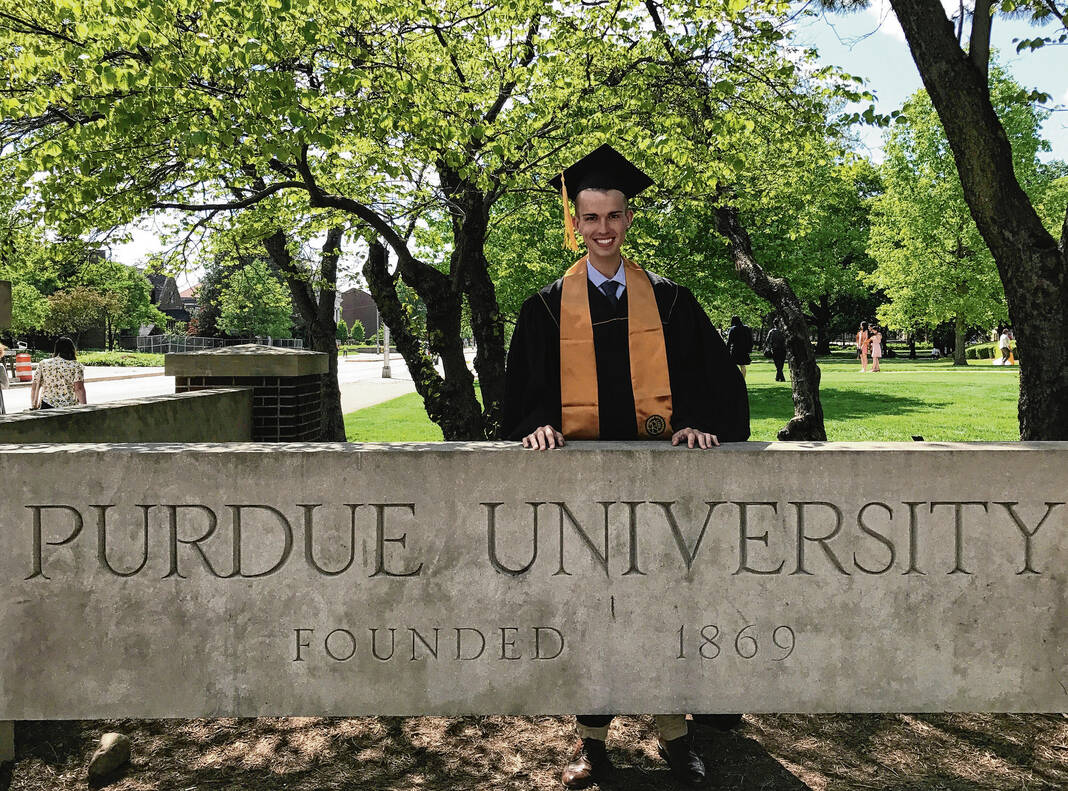
Kaelan Brennan, a 2013 graduate of Seymour High School, earned a Bachelor of Science in biochemistry, summa cum laude, from Purdue University in 2017.
Submitted photo

Seymour native Kaelan Brennan is attending graduate school at the Stowers Institute for Medical Research to earn a doctorate in molecular biology.
Submitted photo
Waking up and checking his phone in the middle of the night, Kaelan Brennan read one of his emails and couldn’t go back to sleep afterwards.
He had spent four months writing an application for the Ruth L. Kirschstein Predoctoral Individual National Research Service Award, aka F31 award, from the Eunice Kennedy Shriver National Institute of Child Health and Human Development of the National Institutes of Health.
The award’s purpose is to enable promising predoctoral students to obtain individualized, mentored research training from outstanding faculty sponsors while conducting dissertation research in scientific health-related fields relevant to the missions of the participating NIH institutes and centers.
The proposed mentored research training must reflect the candidate’s dissertation research project and is expected to clearly enhance the individual’s potential to develop into a productive independent research scientist.
Another six months passed until Brennan received that email letting him know he would be receiving the award.
“While I found out that I was receiving the fellowship concretely in February via email from the NIH, there were a couple of promising signs along the way, such as my application scores and reviewer comments that we received at the end of 2021,” said Brennan, 27, a Seymour native. “From that, we knew that the application was promising, but nothing is ever certain until it actually is.”
The 2013 Seymour High School graduate earned a Bachelor of Science in biochemistry, summa cum laude, from Purdue University in 2017 and now is in graduate school at the Stowers Institute for Medical Research in Kansas City, Missouri, where he’s a candidate for a doctorate in molecular biology.
Once his mother, Hgerian Waldeyer of Seymour, learned the news of the award, she expressed her excitement on Facebook.
She said it’s the most competitive grant for graduate students in biomedical research, and it’s rare to receive it on the first try.
“This is a national award and was hard-earned,” Waldeyer wrote. “To say that I am so very proud is such an understatement. My son, my hero, a man I truly look up to because he teaches me far more than I’ve ever taught him. Forever and for always, this brilliant young man will always have his momma’s heart.”
The funding from this award will be for three years, and Brennan said he expects to graduate within that time frame. While doctorate programs in science don’t set a hard date for graduation, on average, he said people take about six years to complete the degree, and he’s in his fourth year.
“The fellowship covers my training for essentially the rest of my Ph.D.,” he said. “That means that it will cover both in-lab, research activities — the experiments and analyses that I will be doing — as well as my training and career development, such as conferences and/or courses that would benefit my development as an independent scientist.”
Brennan said his interest in science started when he was a student at SHS.
“It was really Paula Swengel, my AP biology teacher, who first made me excited about science,” he said. “In fact, I loved AP biology so much that I petitioned Mrs. Swengel to allow me to take it for a second year in a row just for fun. This was a great experience, and I’m still friends with Paula years later.”
After that, he said he knew he wanted to study molecular biology in college, but he also loved Rick Schuley’s organic chemistry course at SHS, so biochemistry was the perfect major for him.
After graduating from Purdue, he started his doctorate at the University of California, Berkeley before moving to the Stowers Institute for Medical Research.
“Instead of filling my days with classes and exams, the bulk of my time is spent doing research in the lab,” he said. “This means doing experiments and collecting data, analyzing the data using computational tools and communicating those data to my peers and colleagues, either through a formal presentation or a written work, such as a publication.”
While there are a handful of classes required for a doctorate. in the life sciences, Brennan said it’s really the lab work and the outputs of those research tasks that determine one’s progress.
“There are also lots of opportunities for teaching, mentoring and writing, which I very much enjoy taking advantage of,” he said.
Brennan said his professors and school encouraged him to apply for the research fellowship.
From April to July last year, he wrote the application, which included more than 10 documents in the package.
“One of the biggest is the research strategy statement,” Brennan said. “This is a research proposal that outlines the significance, innovation and approach that the applicant will take to address an outstanding question in biomedical research that will have a sizeable impact on the greater community.”
In this document, the applicant describes the importance of his or her research and what specifically (experiments, analyses, etc.) they will do in order to answer the question, he said.
He also had to describe his academic and research background and training goals and objectives under the fellowship, why he selected the particular sponsor and institution and why these choices facilitate the proposed research activities and strong mentoring.
The application was submitted at the beginning of August 2021. Then it went through multiple rounds of review, where experts in the field and at the NIH evaluated the application and applicant in various areas, including their research training plan and training potential.
“Here, the reviews want to make sure that the research goals are both impactful and attainable and that the applicant has the potential to become an independent biomedical research scientist,” Brennan said.
His specific area of research is the field of gene expression regulation.
“In this area, researchers are working on understanding the cellular and molecular mechanisms that are responsible for turning different genes on and off during different times, such as different developmental stages or in response to different environmental stimuli, and in different places (different tissues, cell types, organs, etc.),” Brennan said.
This is really important because they know a huge diversity of diseases are caused by the misregulation of gene expression, or the wrong genes are on/off at the wrong time or the level of “on-ness” or “off-ness” is perturbed, he said.
“So understanding how cells control their gene expression programs will help us ultimately understand how to treat these diseases,” he said.
Research in this field can involve biochemistry, molecular biology, genetics, genomics, developmental biology and bioinformatics and statistics, all of which are employed in the lab.
In his application, Brennan gave this as his project narrative: “Enhancers are regulatory DNA sequences that underlie a wide variety of human diseases when misregulated because they determine when and where a target gene will be expressed. Because these sequences are critical for driving proper spaciotemporal target gene expression during development and cellular transitions, they are maintained in an inaccessible and inactive state until the precise context for gene activation is reached.”
He said his study will aim to characterize how enhancers are made accessible and active by DNA-binding proteins during embryonic development, which will provide mechanistic insight into how cells regulate enhancer activity to control their gene expression programs.
“Ultimately, I hope that the research opportunities and training I receive through this fellowship will augment and facilitate my development into an independent biomedical research scientist and will prepare me for a career in academic research,” Brennan said.
All of the research he conducts is done under the mentorship of his research adviser, Julia Zeitlinger, and his advisory committee at the Stowers Institute.
His ultimate career goal is to be a university professor and run his own research lab.
“I love doing research in the lab and applying the scientific method to outstanding questions in my field, but I also love teaching and mentoring,” Brennan said. “Being a professor and running my own lab will allow me to work in both of these areas.”
While in high school, Brennan said he had no idea he could make a career out of science and conducting research. He liked biology and chemistry but always thought of them as steppingstones for something like medical school.
“So if there’s anything I can impart on the current students at SHS, especially those who are enjoying their science courses and thinking about studying science in college, it would be to explore all of the possibilities a degree in science will provide to you, including research,” he said.
“In a broader sense, finding something you’re passionate about is really the most important thing, be it science or anything else,” he said. “I love research, molecular biology and the scientific enterprise, and so I very much attribute a great deal of my success to my passion for what I do.”
Brennan file
Name: Kaelan Brennan
Age: 27
Hometown: Seymour
Residence: Kansas City, Missouri
Education: Seymour High School (2013); Purdue University (Bachelor of Science in biochemistry, summa cum laude, 2017); Stowers Institute for Medical Research (doctorate in molecular biology, in progress)
Occupation: Doctoral candidate
Family: Mother, Hgerian Waldeyer; father, Scott Brennan; brother, Paetan Brennan; sister, Averie Brennan
